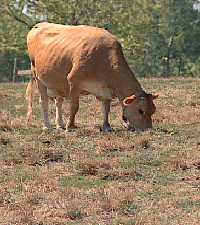Drought Damage to Kentucky's Ag Income May Total Nearly Half Billion Dollars
Drought Damage to Kentucky's Ag Income May Total Nearly Half Billion Dollars

Two University of Kentucky economists have begun ringing up the cost of Kentucky's recent drought. This prolonged natural disaster will send some negative ripples through the Commonwealth's economy well into next year.
"We estimate that the drought's impact on the economy of Kentucky could be in excess of 495 million dollars," said Larry Jones, an economist in the University of Kentucky College of Agriculture .
That figure includes an estimated $330 million dollars in direct farm losses related to actual crop losses. Another estimated $165 million dollars may come from lower revenue realized by the large number of businesses who provide spinoff goods and services to the farming community.
Jones and Steve Vickner, a UK agribusiness economist, teamed up to study the total economic impact on the state's economy resulting from drought damage. Jones felt that the figures were probably a conservative estimate.
"Most of the farm income losses are in four primary crops such as corn, soybeans and tobacco and hay. But the jury is still out on longer term factors such as the potential costs of restoring thousands of acres of pastureland in the state or the ultimate impact on the livestock sector," added Jones.
The UK economists compiled their figures by first interviewing UK College of Agriculture subject matter economists to determine agricultural production shortfalls caused by the drought.
This $330 million was simply an estimate of dollars lost at the farm level. That figure did not deal with the longer term consequences of the drought beyond 1999.
The second step was to take those estimated farm losses and put them through a computerized economic model which estimated the "ripple" effect of the drought on other related sectors of the economy.
"In our model we looked at indirect and induced effects of the drought on the farm economy," said Jones. "The indirect costs totaled around $102 million and induced effects added another $63 million to provide the final tally of $165 million in "ripple" effect costs."
Indirect effects refer to the decline in the purchases of farm inputs such as equipment, fertilizer and seed. Induced effects refer to the decline in purchases by households that are in some way linked to the state's agricultural economy.